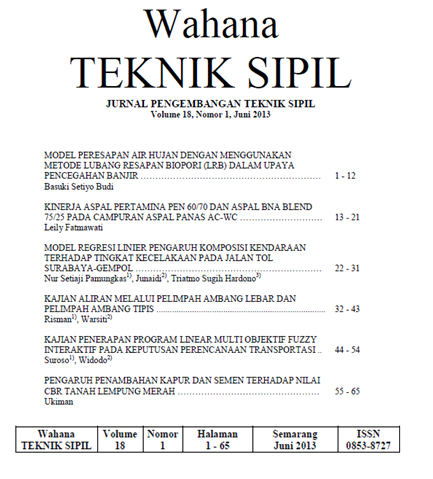Analisis Faktor Konservasi Kombinasi Teras Nikolas Dan Tanaman Kacang Tanah (Faktor Cp Untuk Teras Nikolas + Kacang Tanah)
DOI:
https://doi.org/10.32497/wahanats.v18i2.982Keywords:
conservation factor, corp management, USLE, cultivate land management, nicols terrace, peanuteAbstract
Each of land use is going to give effect to erosion , land damages and run off. Land use policy and it”™s conservation can be ditermined from the prediction result of erosion and the permitted erosion rate that is determined. Peanute is one of agrybisnis comodities that have a higher economic value among some kinds of plants else. It is possible enough to be developed in Indonesia. Sustainable development demands to each land user has to take care of conservation principles in order to getting sustainable use and it”™s pruductivity kept. Land use policy and it”™s conservation can be determined from result of predicted erosion rate and soil loss tolerance. Generally, some factors influence to the erosion rate are precipitation, topography, vegetation and human factor. To anticipate development of peanute plant, it needs to studying about practice factor of concervation and factor of vegetation management. The objective of research is to analyze value of CP factor of USLE equation, that is combination of crop management factor (C) for peanut and practice conservation factor (P) especially nicols terrace. The research is conducted with field measurement approach method by model of plots and by specifications : at field land with 10 % slope, length of land slope 20 m, type of soil Dark Brown Mediterranean (Alfisol/Inceptisol), for about 3 months and amount of precipitation rate about 257.72 mm/month. The research has given a result that CP factor of USLE equation for nicols terrace that combined to vegetation of peanut (CP value for nicols terrace + peanute) is about 0,32.
Downloads
Published
Issue
Section
License
Authors who publish with this journal agree to the following terms:Authors retain copyright and grant the journal right of first publication with the work simultaneously licensed under a Creative Commons Attribution License that allows others to share the work with an acknowledgement of the work's authorship and initial publication in this journal.
Authors are able to enter into separate, additional contractual arrangements for the non-exclusive distribution of the journal's published version of the work (e.g., post it to an institutional repository or publish it in a book), with an acknowledgement of its initial publication in this journal.
Authors are permitted and encouraged to post their work online (e.g., in institutional repositories or on their website) prior to and during the submission process, as it can lead to productive exchanges, as well as earlier and greater citation of published work (See The Effect of Open Access).






